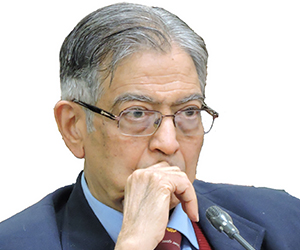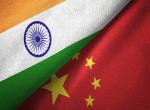The document, prepared by an eminent 8-member group, has attracted both criticism and praise. The latter is mainly for drawing attention to India's innumerable foreign policy challenges and for generating debate thereon.
On the negative side, a major shortcoming in the document is the failure to clearly spell out a vision for what India should aspire to be and how precisely should these aspirations be realised, says Satish Chandra.
Non-alignment 2.0 -- unveiled in January -- is a 60-page document which purportedly outlines the principles that should guide India's foreign and domestic policy over the next decade.
Over a year in the making the document is the handiwork of an eight-member group comprising some well known Indian intellectuals like Shyam Saran, Sunil Khilnani, Nandan Nilekani, and Pratap Bhanu Mehta.
The authors are at pains to claim that the document represents only their views and that it is, therefore, an independent product. This is open to question because Shyam Saran, a former foreign secretary, heads a government-funded think tank and another author, General Prakash Menon is military advisor with the rank of secretary in the National Security Council Secretariat. Moreover, the National Security Advisor and his deputy actively participated in some of the deliberations of the group to which administrative support was provided inter alia by the National Defence College.
Nonalignment 2.0 has attracted both criticism and praise. The latter is mainly for drawing attention to India's innumerable foreign policy challenges and for generating debate thereon. The document is, of course, also studded with several nuggets of wisdom some of which may be enumerated as follows:
India must retain maximum strategic autonomy in order to enable it to pursue its developmental goals;
Since its economic growth requires deepened economic engagement with the world, India must strive to maintain an open global order;
It is unlikely that there will be enduring coalitions: these would require artful management;
India's great advantage is that, barring in its immediate neighbourhood, it is not seen as a threatening power;
Engaging with the Asian theatre will be a key concern for India with South Asia being the most vital;
India must put in place operational concepts and capabilities to deter China since the latter will be a significant foreign policy and security challenge for it;
Progress in India-Pakistan ties can only be incremental;
While seriously pursuing the complete elimination of nuclear weapons on a non discriminatory basis, India must beef up its nuclear weapon capability in particular the maritime leg.
On the negative side, a major shortcoming in the document is the failure to clearly spell out a vision for what India should aspire to be and how precisely should these aspirations be realised. In the absence of such on overarching unity of purpose Nonalignment 2.0 flounders and lacks coherency.
Many have also found fault with the title of the document on the grounds that it is backward looking rather than forward looking. The argument that the title was selected as 'strategic autonomy' was a core element of non-alignment as earlier practiced by India, cuts no ice as such autonomy is something which any self respecting country would like to exercise and as the non-alignment of yester year had many shortcomings.
Given the standing of the authors, one would have expected a much more tautly conceived and constructed document. It, however, disappoints. It is flabby, marred by inaccuracies, and on occasion displays a disquieting naivete. In this context, consider the following propositions contained in it:
India's internal development will depend on how well we manage our global opportunities. Comment: is not the converse truer? In the ultimate analysis progress is dependent more on management of internals than of foreign policy;
The fundamental source of India's power is its example. Comment: comprehensive national power rather than example is what counts for in the real world;
The main thing that can hold India back is India itself. Comment: This is a cliché applicable to all countries;
South Asia is holding India back at many levels and places fetters on its ambitions. Comment: While a fractious neighbourhood is a cause of concern it cannot subvert Indian ambitions as long as India is strong;
India has been granted Most Favoured Nation treatment by Pakistan. Comment: This is incorrect. Pakistan has only moved from a positive to a negative list in respect of its imports from India.
India should engage in cooperation with Pakistan on energy and water, leverage its economic relationship with China for political concessions and persuade the latter to seek reconciliation with the Dalai Lama. Comment: Even a nodding acquaintance with the dynamics of the polity of Pakistan and of China and their relationship with India would indicate that these propositions are non-starters.
Finally, perhaps the most serious flaw in Nonalignment 2.0 is that it reeks of pusillanimity. For instance, it suggests that India should continue to remain engaged with Pakistan even if there are further Mumbai like attacks. All that it contemplates in such eventualities is stand-off punitive operations and goes so far as to argue against deep thrusts into Pakistani territory for fear of nuclear attack missing the point that we have a nuclear deterrent.
Similarly, while suggesting that there can be no proportionate response to a Chinese attack on India it makes a case for an asymmetric response inter alia based upon the creation of insurgencies in areas occupied by China thereby acknowledging defeat even before battle has been joined. It also argues that India should focus more on accretion of its military capability at sea rather than on land. Indeed, the paragraphs relating to China are permeated by an unseemly fear and the thought that India should do nothing which may increase its anxieties, to the extent that we maintain equidistance between China and the US.
Even in respect of our South Asian neighbours the document would have India make unilateral concessions to them. The learned authors appear to have learnt no lessons from the fact that the countless unilateral concessions made by India to China, Pakistan and even Sri Lanka, have not earned it any positive results in terms of improved ties with those countries and only encouraged recalcitrant behaviour.
Ironically, while the document is mindful to a fault of Chinese sensitivities all such caution is thrown to the winds when addressing India. Indeed, it goes so far as to suggest that we need to build a credible state, promote inclusive governance and a political culture attuned to defusing conflict.
These homilies are not only quite out of place in a foreign policy related document but much more applicable to China and Pakistan than to India. Indeed our record on this count is better than that of many countries. The fact that they have found place in such a document is, therefore, not only unwarranted but also a singular disservice to the nation.
Published in rediff.com 12th June 2012









_1_0.png)
Post new comment